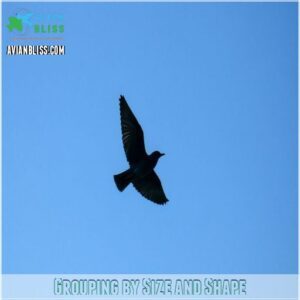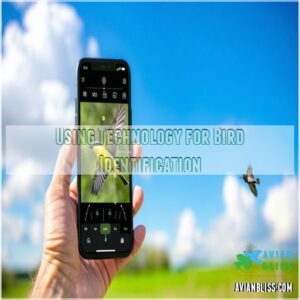This site is supported by our readers. We may earn a commission, at no cost to you, if you purchase through links.

Start with the basics: notice the bird’s silhouette, wing shape, and size compared to familiar birds like sparrows or crows.
Watch how they move – hawks soar in circles like aerial dancers, while woodpeckers bounce through the air like they’re on an invisible pogo stick.
Focus on distinct features like the osprey’s dark wrist patches or a northern harrier’s white rump.
Modern birding apps can help confirm your observations, but mastering the art of reading these aerial signatures opens up a whole new world of discovery.
Table Of Contents
- Key Takeaways
- Identifying Birds in Flight
- Identifying Birds in Flight Made Easy
- Bird Flight Patterns and Forms
- Identifying Raptors in Flight
- Using Technology for Bird Identification
- Enhancing Your Bird Identification Skills
- Frequently Asked Questions (FAQs)
- How do you identify birds in flight?
- How do you identify a bird?
- How do you describe birds in flight?
- How do you know if a bird flies fast?
- How do you know if a bird flies off?
- How do you identify a raptor in flight?
- How to identify birds while flying?
- Is there a device that identifies birds?
- How to tell the difference between a hawk and an eagle in flight?
- Is there an app to take a picture of a bird and identify it?
- Conclusion
Key Takeaways
- You’ll identify flying birds by focusing on silhouettes, wing shapes, and relative size compared to familiar birds like sparrows or crows—it’s your most reliable set of visual clues.
- Watch the bird’s flight pattern—hawks soar in circles, woodpeckers bounce through the air, and hummingbirds dart like helicopters, making each species’ movement style unique.
- Look for distinctive features that stand out in flight, such as an osprey’s dark wrist patches, a northern harrier’s white rump, or a turkey vulture’s V-shaped wing position.
- You’ll become more accurate at bird identification by combining visual observations with modern birding apps, which can confirm your sightings and help you learn new species.
Identifying Birds in Flight
You’ll find that identifying birds in flight is like solving a puzzle in the sky, where each species reveals distinctive clues through its size, shape, and movement patterns.
Just as you’d notice a friend’s unique walk from across the street, you can learn to spot the telltale signs of different bird species by observing their flight styles, from the graceful gliding of eagles to the quick wing beats of sparrows.
Key Characteristics to Look For
When you’re out spotting birds in flight, focus on the basics – it’s like putting together a flying puzzle.
Look at the bird’s silhouette first: wing shape tells you if it’s built for soaring or diving, while tail length hints at maneuverability.
Pay attention to body size and beak structure too.
Colors and markings might catch your eye, but shape and size are your most reliable clues.
Importance of Flight Patterns
Flight patterns tell you more about a bird than any other feature you’ll spot.
Like a fingerprint in the sky, each species has its own way of moving.
You’ll notice hawks soaring in circles, woodpeckers bouncing through the air, and hummingbirds darting like tiny helicopters.
Once you start watching these aerial signatures, you’ll find yourself naturally grouping birds by their unique flying styles.
Tips for Beginners
Starting your bird identification journey might feel overwhelming, but don’t worry.
Begin by focusing on basic silhouettes and wing shapes rather than tiny details, noting that distinctive wing shapes like long, narrow wings for soaring and short, broad wings for agile flight can help narrow down the possibilities.
Keep your binoculars ready and practice following birds with steady movements.
Look for distinctive flight patterns – some birds soar in circles, while others zip straight ahead.
Remember, even experienced birders started as beginners, so take your time learning.
Identifying Birds in Flight Made Easy
You’ll be amazed at how quickly you can master bird identification in flight by focusing on three key features: size, wing shape, and flight pattern.
Whether you’re watching a hawk soar overhead or trying to spot the difference between a swift and a swallow, these simple observation techniques will turn you into a confident sky-watching expert.
Grouping by Size and Shape
Looking up at the sky, you’ll notice birds come in all shapes and sizes – it’s like nature’s own sizing chart!
To make identification easier, try grouping birds by their general silhouette and size.
You can even use a helpful bird shape guide to get a better understanding of the different types of birds.
Here are three key comparisons that’ll help you master this skill:
- Compare to familiar birds (sparrow, crow, goose)
- Notice overall body proportions (chunky vs. slim)
- Check relative size against nearby objects
Recognizing Wing and Tail Patterns
When you’re watching birds soar overhead, their wing and tail patterns become your secret identification tools.
Think of each bird’s silhouette as a unique signature – broad wings often mean you’re spotting a raptor, while V-shaped tails typically belong to swallows.
You’ll notice some birds have distinctive markings, like the osprey’s dark wrist patches or the northern harrier’s white rump patch.
Using Beak Shape and Size
A bird’s beak tells you more than what’s on its dinner menu – it’s a dead giveaway for identification, even in flight.
Seed-eaters will be easy to spot by their short, sturdy beaks.
Birds of prey flash their sharp, hooked bills.
Fish-eaters show off long, pointed beaks.
Insect-catchers zip around with slender, delicate bills.
Once you get the hang of beak shapes, you’re halfway to mastering flight ID.
Bird Flight Patterns and Forms
You’ll notice that birds move through the air in distinct ways, from the graceful soaring of eagles to the quick wingbeats of hummingbirds.
Flight patterns will help you identify different species like a pro.
Whether you’re watching from your backyard or out on a nature trail, understanding these flight patterns will help you identify different species like a pro.
Soaring and Gliding
Birds that soar and glide are nature’s masters of energy efficiency.
You’ll spot them riding thermals with barely a wing flick, using their wingspan to catch rising air currents, a technique that allows them to harness the power of updrafts and air currents.
Eagles and vultures are pros at this, maintaining impressive flight speeds while barely moving a muscle.
Their silhouettes paint perfect pictures against the sky as they circle higher, reaching altitudes where they can survey vast territories below.
Flapping and Diving
A fascinating display of aerial prowess emerges when you observe flapping and diving patterns.
You’ll notice distinct wingbeat frequencies – from the rapid flutter of hummingbirds to the measured wing strokes of herons.
For a deeper understanding, explore bird flight identification tools.
When hunting, diving birds like ospreys and gannets showcase precise air speed control, plunging at steep angles into water.
These predator-prey dynamics offer clear hints for identifying species based on their unique flight patterns.
Perching and Settling
The way a bird settles onto its perch tells you volumes about its identity.
After swooping and diving, these aerial acrobats need to nail their landing.
You’ll spot clear differences in their techniques:
- Songbirds grip forward-facing branches with three toes front, one back
- Woodpeckers land vertically with two toes front and back
- Hawks prefer horizontal perches with powerful, spread talons
- Swifts can’t perch at all – they cling to vertical surfaces
Identifying Raptors in Flight
You’ll spot a raptor’s distinctive silhouette in the sky by looking for their broad wings, hooked beaks, and powerful talons that set them apart from other birds.
Whether you’re watching a red-tailed hawk soaring on thermal currents or a peregrine falcon cutting through the air, you’ll soon discover that these magnificent hunters have unique flight patterns that make them easier to identify than you might think.
Hawks and Eagles
Right up there in the wild blue yonder, telling hawks from eagles isn’t as tricky as you might think.
Eagles typically soar with their wings held flat like boards, while hawks keep theirs in a slight V-shape.
You’ll notice eagles have longer, broader wings and more rectangular tails compared to hawks’ rounded ones.
Watch their hunting styles too – eagles prefer dramatic dives, while hawks often cruise low, searching methodically.
Falcons and Vultures
Spotting the difference between falcons and vultures feels like solving a high-flying puzzle. Here’s what catches my eye when watching these majestic raptors soar overhead:
- Falcons show off their speed with pointed wings and rapid wing beats
- Falcons dive-bomb at incredible speeds, while vultures lazily circle thermals
- Vultures rock a wobbly flight pattern, tilting side to side
- Turkey vultures hold their wings in a distinct V-shape
- Black vultures display shorter, broader wings
- For a deeper dive into raptor identification, consult a raptor field guide.
Tips for Distinguishing Between Species
While falcons and vultures have distinct traits, distinguishing between raptor species comes down to mastering pattern recognition.
For instance, falcons’ remarkable speed is often a key factor in identifying them, especially when compared to hawks.
You’ll want to focus on wing shape, body size, and flight style.
Notice how golden eagles hold their wings in a shallow V, while red-tailed hawks keep them flat.
Pay attention to tail length and shape too – they’re like unique signatures in the sky.
Using Technology for Bird Identification
You’ll find that modern technology transforms bird identification from a guessing game into a precise science, with smartphone apps and digital cameras helping you capture and identify birds in flight like never before.
Whether you’re stumped by a soaring raptor or puzzled by a passing warbler, today’s tech tools can be your virtual bird expert, ready to help 24/7 with instant identification suggestions and expert-verified databases.
Birding Apps and Software
Modern birding apps have revolutionized how we identify birds in flight.
Apps like Merlin and Sound ID use AI to help you match wing patterns, calls, and behaviors with their database.
You’ll get instant results, complete with photos and range maps.
Just remember, while these apps are amazing tools, they’re not infallible – think of them as helpful guides rather than definitive answers.
Camera Traps and Photography
Several wildlife photographers swear by camera traps as their secret weapon for capturing birds in flight.
You’ll get amazing shots without spooking your subjects.
Here’s what you need to know:
- Choose high-speed settings to freeze wing motion
- Position traps along known flight paths
- Use weatherproof housing to protect your gear
- Set multiple angles to increase success rate
- Start with common species to perfect your technique
These tools let you document natural behaviors while building an impressive portfolio of flight shots.
Enhancing Your Bird Identification Skills
You’ll be amazed at how quickly you can identify birds in flight once you’ve mastered the basics of wing patterns, flight styles, and body shapes.
Whether you’re watching a hawk soar overhead or trying to spot the difference between a swift and a swallow, you’ll find that combining careful observation with the right knowledge makes bird identification both exciting and rewarding.
Learning Bird Calls and Songs
Learning to identify birds by their songs and calls is like picking up a new language – it opens up a whole new world of understanding.
You’ll start noticing the difference between a robin’s cheerful morning song and a cardinal’s sharp chip notes.
Modern bird ID apps with sound recognition make this easier than ever – just record the sound and let technology help you match it to a species.
Observing Habitat and Behavior
Bird songs tell part of the story, but watching where and how birds behave adds another layer to your ID skills.
You’ll notice patterns like hawks circling open fields or woodpeckers sticking to mature forests.
Their behavior shifts with seasons too – some species gather in flocks during migration, while others defend territories year-round.
Pay attention to these habitat clues, they’re like nature’s own field guide.
Practicing Identification Techniques
When you’re ready to level up your identification game, consistent practice makes all the difference. Think of it like learning a new language – the more you immerse yourself, the better you’ll get.
- Start with backyard birds, practicing with common species before tackling trickier ones
- Join weekend birdwatching groups to learn from experienced birders
- Use field guides alongside real-time observations
- Record your observations in a digital journal
Frequently Asked Questions (FAQs)
How do you identify birds in flight?
You’ll need to observe the bird’s flight patterns, wing shape, and silhouette against the sky.
Watch for distinctive behaviors like soaring, diving, or flapping, and note body size and color patterns.
How do you identify a bird?
Look for distinctive features like size, shape, color patterns, and behavior.
Focus on the bird’s bill shape, wing patterns, tail length, and any unique markings.
Listen for its calls and songs for additional clues.
How do you describe birds in flight?
Birds reveal their identity through distinct flight patterns: gliding, soaring, or fluttering.
You’ll notice wing shape, size, and motion style.
Watch for unique behaviors like hovering or diving that distinguish different species.
How do you know if a bird flies fast?
Watch for rapid wing beats, streamlined body position, and minimal gliding periods.
You can compare flight speeds to nearby objects, noting how quickly the bird covers distance relative to landmarks or other birds.
How do you know if a bird flies off?
You’ll notice a bird’s departure through sudden movement, wing flutters, or directional changes. If they’re perched, they’ll often lean forward slightly before taking off, giving you a quick heads-up signal.
How do you identify a raptor in flight?
With their distinctive silhouettes soaring overhead, you’ll spot raptors by looking for broad wings, hooked beaks, and tail shapes.
Focus on flight patterns – soaring hawks glide in circles while falcons dive with quick wingbeats.
How to identify birds while flying?
Look for distinctive wing shapes, flight patterns, and size while birds soar overhead.
Take note of their color patterns, tail shape, and how they move – gliding, flapping, or hovering shows unique characteristics.
Is there a device that identifies birds?
Several smartphone apps like Merlin Bird ID and BirdNet act as your digital birding companion.
They’ll analyze bird photos or sounds in real-time, helping you identify species with impressive accuracy through AI technology.
How to tell the difference between a hawk and an eagle in flight?
Eagles have longer, broader wings that extend straight out like planks when soaring, while hawks’ wings form a slight V-shape.
You’ll notice eagles glide more smoothly, and they’re noticeably bigger than hawks.
Is there an app to take a picture of a bird and identify it?
Just like your smartphone can recognize faces, apps like Merlin Bird ID, iNaturalist, and Audubon Bird Guide can identify birds from your photos with impressive accuracy.
They’ll tell you species, habits, and sounds.
Conclusion
Like a detective piecing together clues, learning how to identify birds in flight transforms your outdoor experiences into thrilling adventures of discovery.
You’ll soon recognize the telltale signs – from a hawk’s broad-winged soar to a hummingbird’s distinctive hover.
With practice, patience, and these expert tips, you’ll be confidently spotting birds on the wing.
Remember, every birder started as a beginner, so grab your binoculars and head outside.
The sky’s aerial theater awaits your expert eye.













